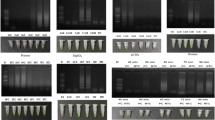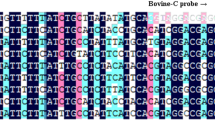Abstract
In order to prevent fraud in the sale and strengthen quality assurance, authentic identification of chicken meat is essential. In the present investigation, a chicken (Gallus gallus)-specific polymerase chain reaction (PCR) was developed for the unambiguous identification of chicken meat. The PCR assay employs pair of primers designed against chicken nuclear 5-aminolevulinate (ALA) synthase gene. Highly chicken-specific diagnostic amplicon of 288 bp was established upon PCR and was evident in all the nine breeds/strains of chicken species. Sensitivity of PCR in detecting chicken meat adulteration was established to be at 0.1 % in the foreign meat matrix, while limit of detection (LOD) of chicken DNA was 10 pg. Suitability of the developed chicken-specific PCR was validated and confirmed in raw, cooked/heat treated (60, 80, 100, and 121 °C), and micro-oven cooked meat samples. Possibility of cross-amplification of adulterating DNA was excluded by cross-checking the developed PCR assay with several animal and avian species. The PCR assay developed in this study is highly promising for applications involving circumstances that require authentic identification of chicken meat.





Similar content being viewed by others
References
Ghovvati S, Nassiri MR, Mirhoseini SZ, Heravi MA, Javadmanesh A (2009) Fraud identification in industrial meat products by multiplex PCR assay. Food Control 20:696–699
Ayuso R, Lehrer SB, Tanaka L, Ibanez MD, Pascual C, Burks AW, Sussman GL, Goldberg B, Lopez M, Reese G (1999) Ig-E antibody response to vertebrate meat proteins including tropomyosin. Ann Allergy Asthma Immunol 83:399–405
Hopwood AJ, Fairbrother KS, Lockley AK, Bardsley RG (1999) An actin gene-related polymerase chain reaction (PCR) test for identification of chicken in meat mixtures. Meat Sci 53:227–231
Lockley AK, Bardsley RG (2002) Intron variability in an actin gene can be used to discriminate between chicken and turkey DNA. Meat Sci 61:163–168
Hitchcock CHS, Crimes AA (1985) Methodology for meat species identification: a review. Meat Sci 15:215–224
Patterson RLS, Jones SJ (1990) Review of current techniques for the verification of the species of origin of meat. Analyst 115:501–506
Stamoulisa P, Stamatisa C, Sarafidoua T, Mamuris Z (2010) Development and application of molecular markers for poultry meat identification in food chain. Food Control 21:1055–1061
Chikuni K, Ozutsumi K, Koishikawa T, Kato S (1990) Species identification of cooked meats by DNA hybridization assay. Meat Sci 27:119–128
Janssen FW, Hagele GH, Buntjer JB, Lenstra JA (1998) Species identification in meat using PCR-generated satellite probes. J Indust Microbiol Biotech 21:115–120
Matsunaga T, Chikuni K, Tanabe R, Muroya S, Shibata K, Yamada J, Shinmura Y (1999) A quick and simple method for the identification of meat species and meat products by PCR assay. Meat Sci 51:143–148
Partis L, Croan D, Guo Z, Clark R, Coldham T, Murby J (2000) Evaluation of a DNA fingerprinting method for determining the species origin of meats. Meat Sci 54:369–376
Sambrook J, Russell DW (2001) Molecular cloning: a laboratory manual, 3rd edn. Cold Spring Harbour Laboratory Press, Cold Spring Harbour
Bellis C, Ashton KJ, Freney L, Blair B, Griffiths LR (2003) A molecular genetic approach for forensic animal species identification. Forensic Sci Int 134:99–108
Walker JA, Hughes DA, Anders BA, Shewale J, Sinha SK, Batzer MA (2003) Quantitative intra-short interspersed element PCR for species-specific DNA identification. Anal Biochem 316:259–269
Walker JA, Hughes DA, Anders BA, Shewale J, Sinha SK, Batzer MA (2004) Quantitative PCR for DNA identification based on genome-specific interspersed repetitive elements. Genomics 83:518–527
Buntjer JB, Lamine A, Haagsma N, Lenstra JA (1999) Species identification by oligonucleotide hybridization: the influence of processing of meat products. J Sci Food Agri 79:53–57
Hird H, Goodier R, Hill M (2003) Rapid detection of chicken and turkey in heated meat products using the polymerase chain reaction followed by amplicon visualization with vistra green. Meat Sci 65:1117–1123
Dooley JJ, Paine KE, Garrett SD, Brown HM (2004) Detection of meat species using TaqMan real-time PCR assays. Meat Sci 68:431–438
Tanabe S, Hase M, Yano T, Sato M, Fujimura T, Akiyama H (2007) A real-time quantitative PCR detection method for pork, chicken, beef, mutton and horseflesh in foods. Biosci Biotechnol Biochem 71:3131–3135
Karabasanavar NS, Singh SP, Shebannavar SN, Kotresh AM, Girish PS, Umapathi V (2010) Identification of avian species using polymerase chain reaction and sequence analysis of mitochondrial 12 s rRNA gene. Vet Arhiv 80:653–661
López-Andreo M, Lugo L, Garrido-Pertierra A, Prieto MI, Puyet A (2005) Identification and quantitation of species in complex DNA mixtures by real-time polymerase chain reaction. Anal Biochem 339:73–82
Mane BG, Mendiratta SK, Tiwari AK (2009) Polymerase chain reaction assay for identification of chicken in meat and meat products. Food Chem 116:806–810
Mendoza-Romero L, Verkaar EL, Savelkoul PH, Catsburg A, Aarts HJ, Buntjer JB, Lenstra JA (2004) Real-time PCR detection of ruminant DNA. J Food Prot 67:550–554
Krmáø P, Renèová E (2001) Identification of bovine-specific DNA in feedstuffs. J Food Prot 64:117–119
Lahiff S, Glennon M, O’Brien L, Lying J, Smith T, Maher M, Shilton N (2001) Species-specific PCR for the identification of ovine, porcine and chicken species in meat and bone meal (MBM). Mol Cell Probe 15:27–35
Meyer R, Hoefelein C, Luethy J, Candrian U (1995) Polymerase chain reaction-restriction fragment length polymorphism analysis: a simple method for species identification in food. J AOAC Int 78:1542–1551
Calvo JH, Osta R, Zaragoza P (2002) Quantitative PCR detection of pork in raw and heated ground beef and pate. J Agric Food Chem 50:5265–5267
Brodmann PD, Moor D (2003) Sensitive and semi-quantitative TaqMan™ real-time polymerase chain reaction systems for the detection of beef (Bos illia) and the detection of the family Mammalia in food and feed. Meat Sci 65:599–607
Acknowledgments
The authors thank i. the Department of Biotechnology (DBT), Government of India, New Delhi, ii. The Dean, College of Veterinary and Animal Sciences, G.B.P.U.A.T., Pantnagar, and iii. The officials of High Altitude Zoo, Nainital (Uttarakhand, India) for their support rendered in accomplishing this work.
Author information
Authors and Affiliations
Corresponding author
Rights and permissions
About this article
Cite this article
Karabasanavar, N.S., Singh, S.P., Kumar, D. et al. Development and application of highly specific PCR for detection of chicken (Gallus gallus) meat adulteration. Eur Food Res Technol 236, 129–134 (2013). https://doi.org/10.1007/s00217-012-1868-7
Received:
Revised:
Accepted:
Published:
Issue Date:
DOI: https://doi.org/10.1007/s00217-012-1868-7




